This post was last updated on January 18th, 2023
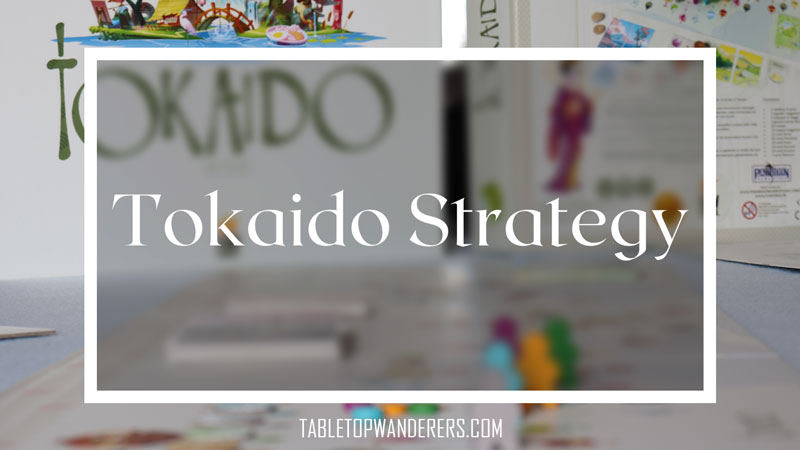
I might be late to write a Tokaido strategy since it’s a game that’s been released a while ago, in 2012, but for me, the best way to celebrate its 10th anniversary is to write a fully detailed guide that should hopefully help you when you feel frustrated by the many lost games.
Even though the game has already blown many candles out, I still get friends asking for advice on how to win more games so this made me write this article.
The gameplay itself is very straightforward and the rules are simple, but there are some mechanics and choices that will drastically increase or decrease your chances to win.
If you want to know more about the game, you can find my personal review here: Tokaido Review.
If, on the other hand, you’re only interested in winning more games and you don’t care about the review then keep reading because this will be my 10th-anniversary gift for you right here!
Quick premise: this is a strategy for the Tokaido base game only, without expansions!
- Tokaido Strategy – Core Concepts
- Tokaido Strategy – 10 Tips to win more games
- #1 | Never run out of money
- #2 | Stop at the Village to buy Souvenir
- #3 | Don't sleep on the Temple
- #4 | Inns are amazing if you can consume a cheap meal
- #5 | Every character possesses unique abilities
- #6 | Try to block opponents' strategy
- #7 | Don't rush forward skipping spaces
- #8 | Hot Springs are free points
- #9 | Encounters cards are high risk-high reward
- #10 | Panorama yes or no?
This post may contain affiliate links. If you click through and make a purchase, I will get a commission at no extra cost to you. See our Affiliate Disclosure.
Tokaido Strategy – Core Concepts
To fully comprehend all the points in this Tokaido strategy guide, it’s important for me to list a few core concepts that will ease the reading.
I like to make these sorts of premises, similar to what I did for the Hive strategy, because it helps to set in stone some very important concepts that might not be deeply explained in the 10-point list itself.
Coins are fundamental
In a game where all the players are travelers that follow the famous Tokaido road and try to make the most out of their journey, coins are of course very important.
Coins allow players to buy souvenirs when entering a Village, make donations to the Temple, and consume a well-deserved meal at the Inn.
These 3 things, as we’ll see later, are possibly the activities that give you the best return in points for each coin you spent.
Understand how many points you get when you spend a coin
I said coins are fundamental in this game, true, but more importantly, it’s how you spend them that it’s going to secure your victory or drag you into despair.
It’s true that this game is often played without the desire of winning in mind, at least for me, but if you truly want to win the next time you play, you will have to understand where and when it’s worth spending your coins.
There are multiple activities you can choose from in Tokaido but not all of them will return a good amount of points for each coin that comes out of your pocket.
Foreshadowing what you’re going to read later on in the article, I can tell you that a good amount of points per coin is something nearby 3. That’s your goal ideally.
The character you choose will determine how easy or difficult the journey will be
Tokaido is very character-centric.
I’m not even sure if that word exists, but the short explanation of it would be the following: the game and the chance for you to win are very dependent on the character you choose since some of them are better than others.
There are 2 main factors to consider when it comes to selecting a character: the amount of starting coins and its ability; the sum of these 2 things will give us a good idea of how strong a character is.
Quick example: Hiroshige the Artist starts with 3 coins and the ability to get a panorama card of his choice at each intermediate Inn. Kinko the Ronin starts with 7 coins and the ability to pay for each meal with 1 less coin.
Between the 2 characters, the difference is very broad, Kinko is way superior, and choosing him over Hiroshige will increase your chances to win.
These were the 3 core concepts I wanted to highlight, now it’s time to dive properly into the Tokaido strategy itself.
Tokaido Strategy – 10 Tips to win more games
#1 | Never run out of money
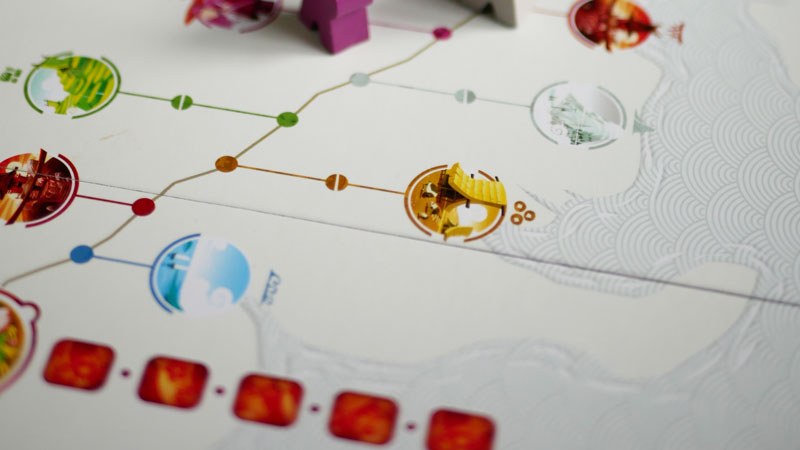
I have already stated how coins are vital in this game since they let you score points.
The primary source to get money is to stop at the Farm, which lets you earn 3 coins instantly! Be sure to stop there when your pockets are light.
So the best advice here is to never ever run out of money or you’ll be screwed.
When you have no money the opponent players can easily stop you from going to the farm and you’ll miss a lot of opportunities to score points along the way.
Depending on the character you choose it’s also very important to have some coins before arriving at any Inns, I would recommend having at least 2 in order to have more choices.
#2 | Stop at the Village to buy Souvenir
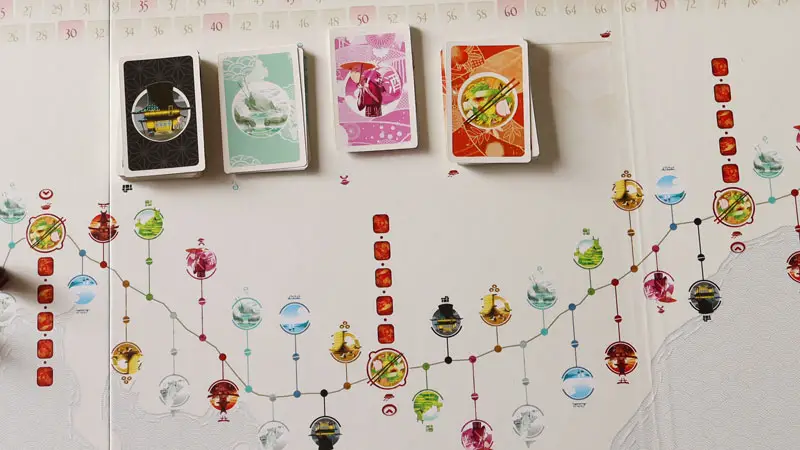
The Souvenir shopping spree is one of the best activities to gain a good amount of points, therefore try to complete one or more sets with fewer possible stops.
A complete set of Souvenir gives you 16 points at the cost of 6, 7, or 8 coins (the total cost will vary because items in the same category have different prices).
Your return of points for each coin you have spent would be the following:
- 2,66 points/coin (for a total of 6 coins spent)
- 2,28 points/coin (for a total of 7 coins spent)
- 2,00 points/coin (for a total of 8 coins spent)
Try to spend the fewer coins you can to maximize your points return.
This strategy is particularly suited for characters with a high amount of coins since the beginning (not you Satsuki!).
Bonus: the player who has the most Souvenir cards will get the Collector Achievement that gives you 3 additional points.
#3 | Don’t sleep on the Temple
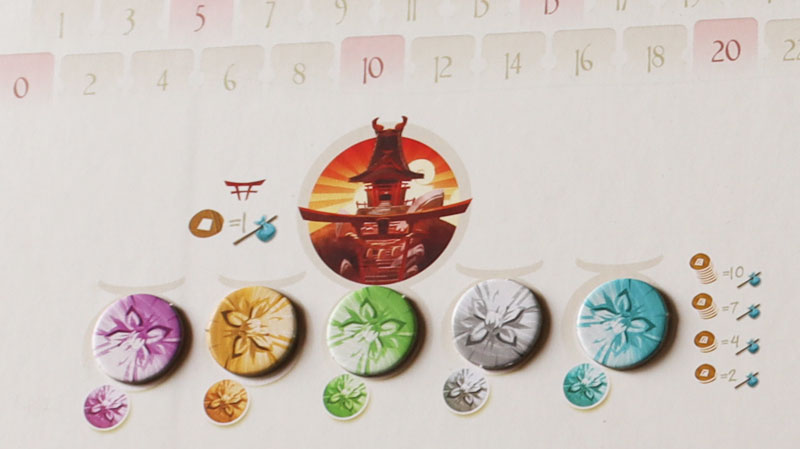
Every time I play with my friends, the Temple is among the activities that are almost always ignored.
I think the main reason is that you don’t get a substantial return of points when you spend money; when you stop at the Temple you must donate 1 to 3 coins and in return, you’ll immediately score 1 point for each donated coin.
The ratio of points/coin here is 1 and it is very low.
But, at the end of the game, travelers score additional points depending on their ranking as donors to the Temple:
- The most generous player scores 10 points.
- The second scores 7 points.
- The third scores 4 points.
- All other donors score 2 points.
Most of the time a donation of 3 or 4 coins secure the 2nd place, and sometimes the 1st depending on how good/focused other players are.
Considering a total expense of 3 coins, your return of points for each coin you have spent would be the following:
- 4,33 points/coin for a 1st position
- 3,3 points/coin for a 2nd position
- 2,33 points/coin for a 3rd position
So what did we learn here? Don’t skip the Temple!
#4 | Inns are amazing if you can consume a cheap meal
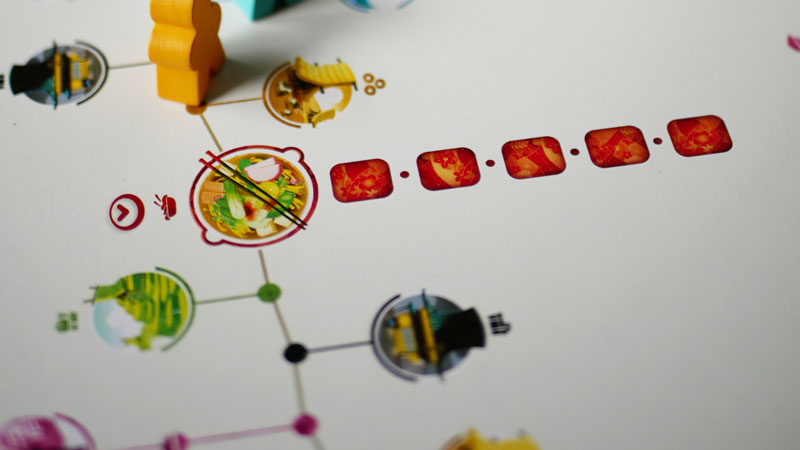
Every time you stop at the Inn you can buy a meal that gives you 6 points regarding the price you spend for buying it.
There are 2 main rules to take into consideration when you stop here:
- The first player who arrived is the first that gets to choose the meal and therefore has more choice than those who follow.
- A traveler can’t buy the same meal twice during the journey.
Keep these rules in mind when you plan your stops at the Inns because if you want to maximize the points per coin value you will have to spend fewer coins as possible:
- 6,00 points/coin for a 1-coin meal
- 3,00 points/coin for a 2-coins meal
- 2,00 points/coin for a 3-coins meal
Always aim for the cheapest meal, try to remember what other players have eaten in order to narrow down their choices, and lastly, try to arrive at the Inn with at least 2 coins as you don’t want to lose 6 points just because you don’t have enough money to buy your dinner.
Bonus: the player who has spent the most on his meal will get the Gourmet Achievement that gives you 3 additional points. (I wouldn’t aim for this personally!)
#5 | Every character possesses unique abilities
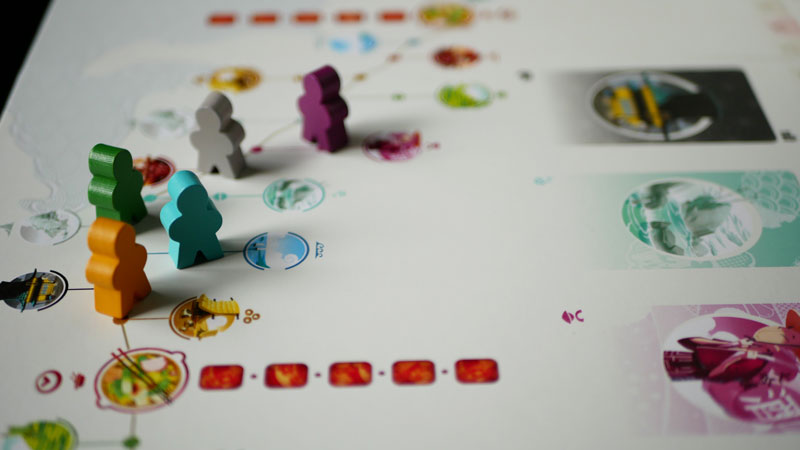
We are halfway through this Tokaido strategy guide and it’s time to speak about characters!
I have said that Tokaido is very character-centric, in fact, there’s an absolute asymmetry in the gameplay that can be accentuated by the choice of the character.
There are characters that are way better than others, however, despite which character you choose there’s a tip always valid: each character has a unique ability so you better exploit that strength to increase your chances to win!
Let’s take Yoshiyasu the Functionary as an example. His ability allows him to draw 2 Encounter cards and keep the one he wishes, instead of just drawing 1 card.
It would make sense to play around with this ability and try to land on as many encounters stop as possible in order to capitalize on his power.
#6 | Try to block opponents’ strategy
Remember when I said that each character has its own ability and how important it is to exploit that?
That could be very much a game changer in both positive and negative ways, let me explain it further using again Yoshiyasu the Functionary as an example.
Your opponent has chosen him and you know that part of his strategy will likely be to try to get his character as many Encounters cards as possible, because of his ability.
What could you do about that? You guessed right, you could try to block him by placing your character in those spaces before him.
Now, I wouldn’t base my entire strategy on blocking the opponents as that would be silly and not fun at all, but since you can see the points scored by anyone at any point in the game, I would take into consideration this part of the strategy to block the opponent that’s closer to your position if that would likely secure your victory.
#7 | Don’t rush forward skipping spaces
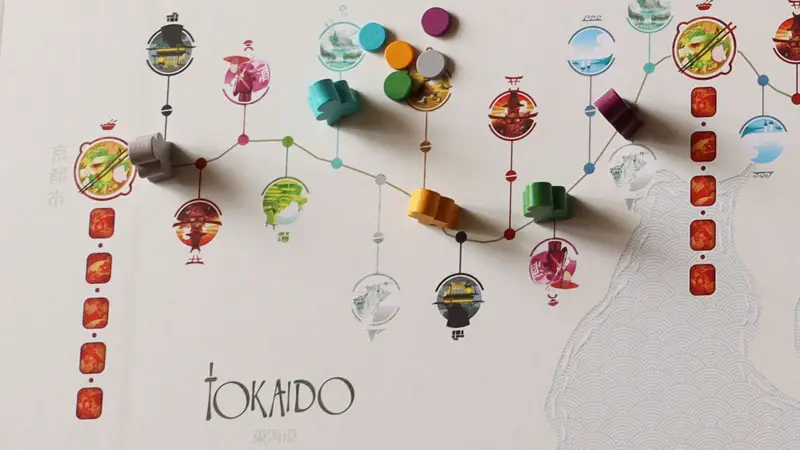
When you start learning how to play Tokaido, under the section “Playing the game” on the official rules, there’s a phrase written in a red coloured font that says:
In Tokaido, the player whose Traveler is farthest behind on the road (with respect to the destination) is the player who takes the next turn.
This is the rule that explains the core gameplay mechanic, and it’s very important because the farthest behind you are, the more times you can move, which means more spaces to land on, which equals more points.
On the other hand, if you skip spaces to reach a certain stop – let’s say you want an encounter and you skip 3 spaces to get there before the others – you will do fewer actions, which likely means fewer points.
This is particularly true in the early/mid game when you want to build your strategy and get as many points as you can. Towards the second half/end game you could be a bit more selective with the spaces you want since the objective there is trying to maximize your returns of points based on the strategy you built earlier in the game.
#8 | Hot Springs are free points
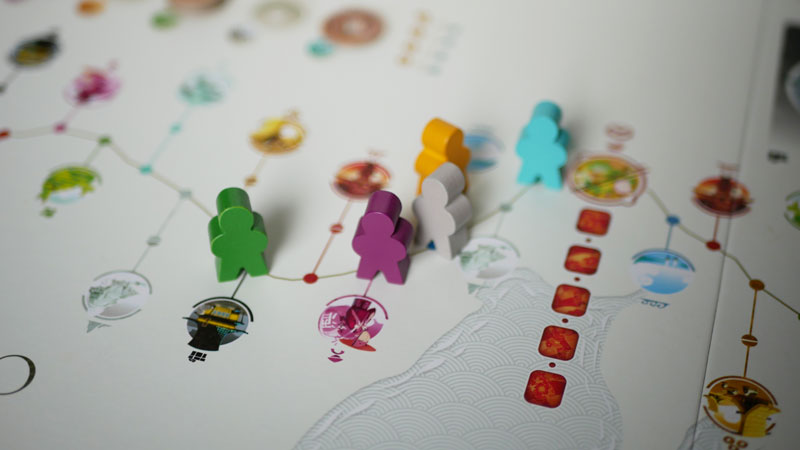
This is very straightforward advice: when you land on hot springs spaces you will get 2 or 3 points in return for free, which is a very good deal!
I talked about the importance of the “points per coin” value and stopping here when you can is a no-brainer, at least in the base game.
These particular spaces will get even more important for characters like Mitsukuni the old man.
Bonus: the player who has the most Hot Springs cards will get the Bather Achievement that gives you 3 additional points.
#9 | Encounters cards are high risk-high reward
When you land on an encounters space you will get a random card from the encounters cards list. They are free and depending on what you get it can be a very good deal or a bad one.
There are 6 different types of cards you can get and each one of them comes in multiple copies:
- Annaibito x6: you gain a random panorama card (1 field, 2 mountains, 3 seas)
- Samurai x2: you score 3 points
- Shokunin x2: you gain a random souvenir card
- Kuge x2: you earn 3 coins
- Miko x2: 1 coin (+ 1 point) to the Temple from the bank
You will get a panorama card approximately 43% of the time you land on an encounter space and each of the other types the 14% of the time.
Some of the rewards such as Kuge, Samurai, or Miko are very high quality but it’s all luck-dependent and that’s why I said high risk-high reward.
I wouldn’t personally base my strategy around the encounters unless I’m playing with characters like Yoshiyasu the functionary or Umegae the street entertainer.
Bonus: the player who has the most Encounters cards will get the Chatterbox Achievement that gives you 3 additional points.
#10 | Panorama yes or no?
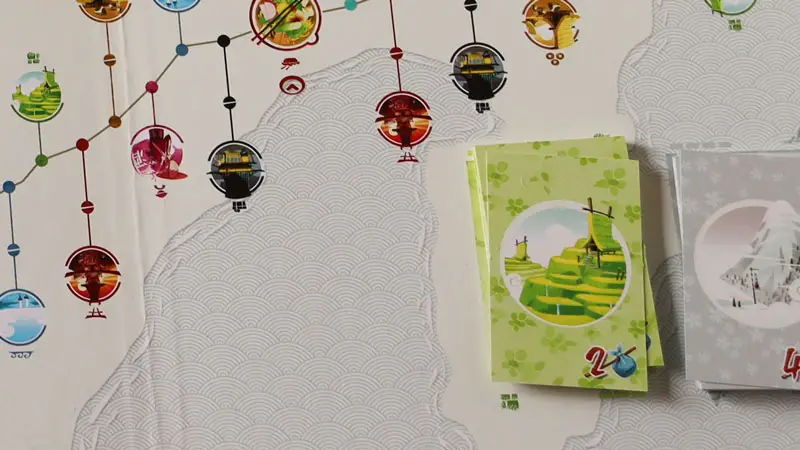
The last tip on my Tokaido strategy is reserved for the Panorama cards because I have mixed feelings about this type of activity.
There are 3 types of panorama sets you can complete and each of them is made of a different number of cards and have different value:
- Green Field Panorama set (3 cards): 1+2+3 = 6 points
- Silver Mountain Panorama set (4 cards): 1+2+3+4 = 10 points
- Blue Sea Panorama set (5 cards): 1+2+3+4+5 = 15 points
It’s true that stopping at these places is free points and by looking at the list above the total score is very juicy, but at what cost?
To complete a Panorama you have to stop respectively 3, 4, or 5 times (with few exceptions) and you are usually up against all the other players that are very much attracted by these stops. At least from what my experience tells me.
I don’t usually base my strategy around Panorama sets and I use these stops mainly to get a few free points here and there.
If you complete any Panorama and you are the first to do so, you’ll get a Panorama Achievement that gives you 3 additional points.